Birds Affected by the Buzzards Bay Bouchard Oil Spill
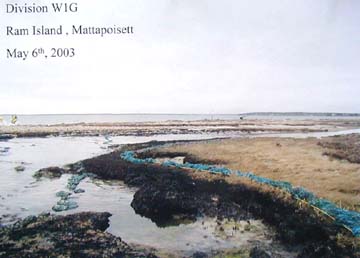
Birds Affected by the Bouchard No. 120 Oil Spill
No. 6 fuel oil can be very adverse to wildlife, and as noted on our No. 6 fuel oil information page, bird mortality is relatively high compared to other oils. Two species of Loon account for half the bird deaths, but 38 species altogether are represented among the birds killed in lists released by the US Fish and Wildlife service.
Nearly 500 oil birds were collected dead or alive. The final death toll of birds with remains collected is estimated to be 479. An evaluation of estimated birds killed but not found onshore remains under study through the Natural Resource Damage Assessment studies. As shown in the graph below, most mortality occurred in May, and no mortalities were reported in July. The official bird death toll attributed to this spill may be revised later.
For some other spills, the number of birds assumed to be killed was estimated to be two or three times the number of birds found dead, but such adjustments are more typical for oil spills in remote areas. In Buzzards Bay, with its highly developed utilized coastline, the number of birds killed, but not found may only be assumed to be a fraction of those found dead. A preliminary estimate of birds found is shown in the table below, but a finalized list will be released when the NRDA damage assessment report is released, probably late in 2005.
Survivorship of captured oiled birds was only 10.9% (164 of the 184 birds captured died). This is lower than expected for No. 6 fuel oil, and many believe the higher mortality is the result of higher the toxicity of this No. 6 oil. Of the total birds killed, 315 were DOA.
Of special interest is the fact that Buzzards Bay has the largest colony of Roseate Terns in North America, a US endangered species. Roseates have been relocating to Ram Island (Mattapoisett) during the last eight years and the overall population is expanding. In 2000, 988 mating pairs were observed on Ram Island, Mattapoisett, 1,130 pairs on Bird Island, Marion (4,236 birds total). In contrast, in 1997, only 253 mating pairs were observed on Ram Island, Mattapoisett, and 1,179 pairs on Bird Island, Marion (2,864 birds total), with occasional pairs on Penikese and Nashawena Islands in the Elizabeth Island Chain. Ram Island may have overtaken Bird Island in 2001 and 2002 in terms of number of Roseate pairs, but we have not yet obtained those statistics. Roughly 3,000 mating pairs (6,000 birds) are known in Northeastern North America. This spill comes at a bad time because the terns arrive in Late April-early May to establish nests and mating pairs.
Two Roseates Terns with evidence of oil have now been found dead, and they are being studied to determine if the deaths are oil related.
On May 30, after weeks of intense cleanup efforts, cleanup crews completed their work on Rams Island, and departed. Hazing canon operations also ceased that day, and the birds were allowed to nest on the Island.
In Buzzards Bay, there are also many breeding sites for the US Endangered Piping Plover. It has been widely reported that Piping Plovers and their nests have been oiled, particularly in the Westport-Dartmouth area, and two Piping Plovers were found dead, with some oiling, but their deaths have not been officially attributed to the spill. Most plovers laid eggs in May and chicks hatched in June. Preliminary reports have suggested that egg hatching and brood survival this year was near typical, but no official statistics have been released. For the NRDA assessment, the nesting success and survival of both endangered species will be statistically evaluated and compared to identical or comparable species in unoiled areas to determine if any observed declines in fecundity can be attributed to the oil spill.
Buzzards Bay Tern Restoration Info
U.S. Fish and Wildlife page of images of wildlife losses
U.S. Fish and Wildlife page of Wildlife Rehabilitation Images
U.S. National Biological Service Fact sheet on the Roseate Tern
In the table below we list the current, but preliminary, best estimate of oiled birds found. Below the table we show pictures of some of the harder hit species.
| Species | Collected Dead | Collected Live | Oiled Survived | Total Collected |
| American Oystercatcher | 0 | 1 | 0 | 1 |
| Black Duck | 2 | 0 | 2 | |
| Black Scoter | 24 | 7 | 3 | 31 |
| Bufflehead | 6 | 1 | 1 | 7 |
| Canada Goose | 4 | 2 | 1 | 6 |
| Common Eider | 37 | 12 | 4 | 49 |
| Common Loon | 76 | 128 | 9 | 204 |
| Common Tern | 6 | 2 | 0 | 8 |
| Cormorant | 1 | 0 | 1 | |
| DC Cormorant | 13 | 2 | 0 | 15 |
| Dunlin | 12 | 0 | 12 | |
| Gannet | 3 | 1 | 0 | 4 |
| Great Cormorant | 3 | 1 | 0 | 4 |
| Greater Scaup | 1 | 0 | 1 | |
| Great Black Back Gull | 14 | 1 | 0 | 15 |
| Gull | 1 | 0 | 1 | |
| Herring Gull | 14 | 4 | 0 | 18 |
| Hooded Merganser | 1 | 0 | 1 | |
| Horned Grebe | 2 | 0 | 2 | |
| Long-Tailed Duck | 10 | 2 | 0 | 12 |
| Mute Swan | 3 | 0 | 3 | |
| Northern Gannet | 1 | 0 | 1 | |
| Passerine | 1 | 0 | 1 | |
| Piping Plover | 1 | 0 | 1 | |
| Piping Plover (chick) | 0 | 1 | 0 | 1 |
| Razorbill | 4 | 0 | 4 | |
| Red Breasted Merganser | 5 | 6 | 1 | 11 |
| Red Necked Grebe | 8 | 1 | 0 | 9 |
| Red Throated Loon | 28 | 9 | 0 | 37 |
| Ring Billed Gull | 4 | 0 | 4 | |
| Roseate Tern | 3 | 0 | 3 | |
| Scoter | 1 | 0 | 1 | |
| Sooty Shearwater | 1 | 0 | 1 | |
| Surf Scoter | 7 | 2 | 0 | 9 |
| Unknown | 8 | 0 | 8 | |
| White Winged Scoter | 4 | 1 | 1 | 5 |
| Willet | 2 | 0 | 2 | |
| Yellow Legs | 4 | 0 | 4 | |
| Total: | 315 | 184 | 20 | 499 |
Death Toll as of June 2003
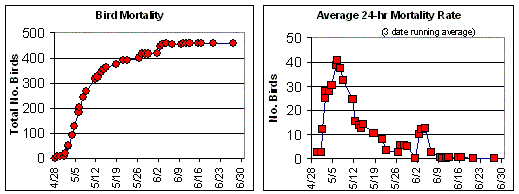
The graph above of bird mortality includes both birds found dead, and captured oiled birds that died in captivity as of the dates shown. The anomalous increase in bird mortality the first week of June is an artifact of the reporting because at the end of May and early June, not all daily reports of bird kills were being forwarded to the Incident Command Center. The apparent increase in bird mortality the first week of June merely reflects the belated reporting of bird mortality. Some additional birds died or were found dead in the ensuing weeks. This graph does not include any birds that may have died and their bodies not found or recovered.
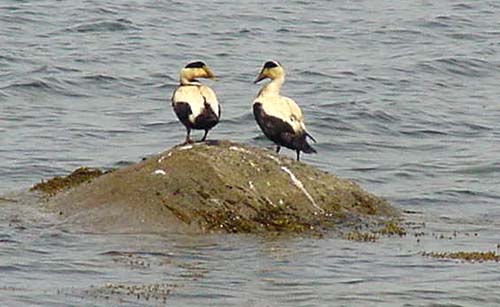
This photograph shows two male eiders on rocks off Mishaum Point in Dartmouth, on May 4, 2003. Mishaum Point had a moderate level of oiling, but the dark coloration on their lower body of these males is their normal coloration, and they may or may not have any oil on them. [Photo credit: W. Janicek, photo from Massachusetts DEP archive].
[All photos and information below taken from Mass Audubon Field Guide]
Common Loon
The Common Loon (Gavia inmer)is a goose sized, heavy, long bodied water bird with a thick pointed bill, found both in freshwater and coastal bays throughout the US and Canada. In summer, it has a white collar, and white spots on the wings but in winter, the crown hind neck and under parts are grayish, but it retains a white throat and under parts. Like the cormorant, it rides low in the water. It has two distinct calls. Anyone who has camped in backcountry or lives in rural areas knows the distinct nighttime call of “Oo-AAAAAH-ho.”
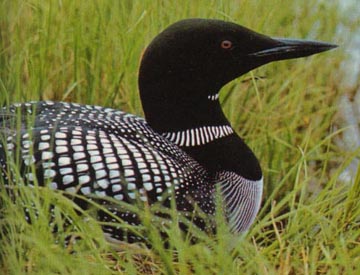
Loon, summer plumage
Double Crested Cormorants
The Double Crested Cormorant (Phalacrocorax auritus) is a goose sized upright perching water bird, dark colored, with a slender body, a hooked bill, and a orange throat poach. Its voice is a deep guttural grunt. Cormorants are the seabird most often seen sunning themselves on rocks with wings outstretched, and “fly” underwater for minutes at a time, capturing fish.
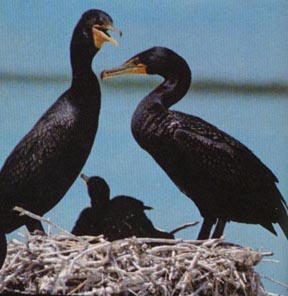
Cormorant
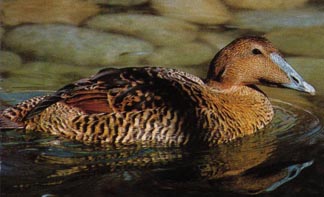
Common Eider
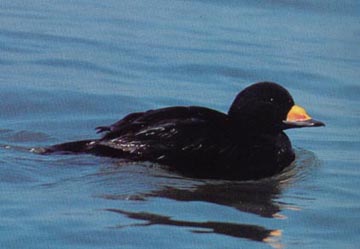
Black Scoter
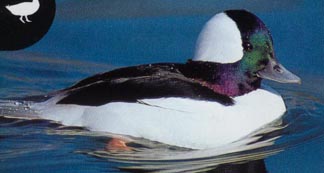
Bufflehead
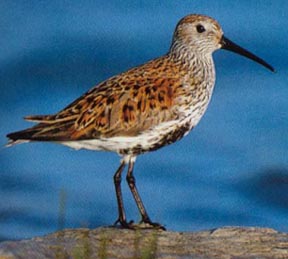
Dunlin
Piping Plover
Piping Plover were also affected by the oil spill, particularly in the Barneys Joy area of Dartmouth. below are two photographs taken of plover there on May 3, 2003. Some plover were observed oiled. Photos by Mass Wildlife staff.
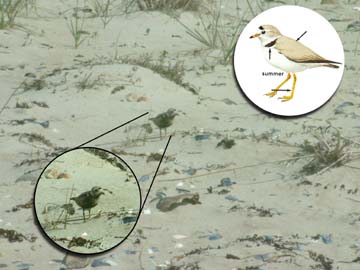
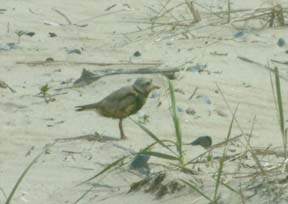
Visit the Sea Duck Joint Venture website for sea duck pictures .
Visit the USGS Bird Info Center